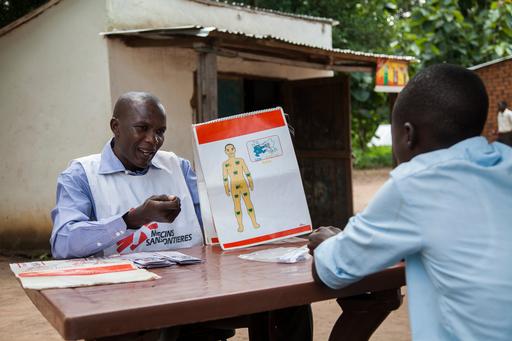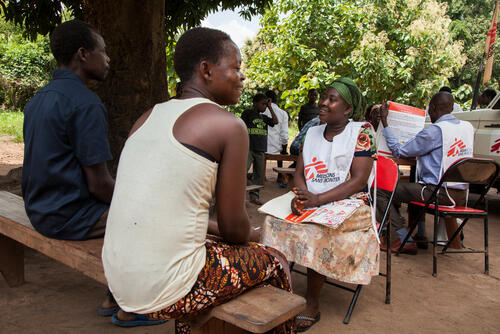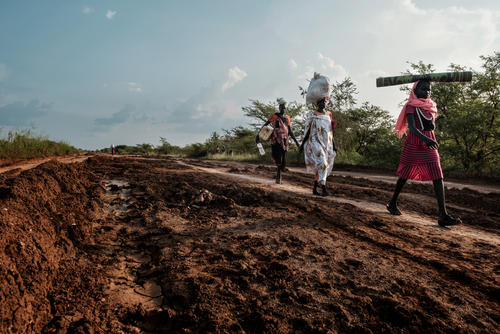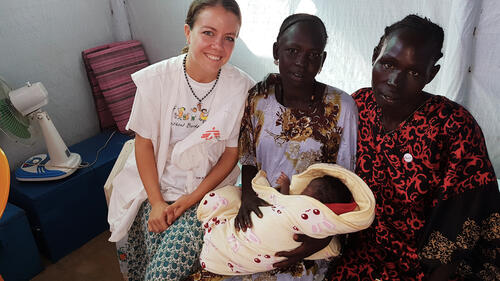Executive Summary
In June 2015, MSF OCBA with the cooperation of the South Sudan Ministry of Health and the World Health Organization (WHO), launched a community-based ‘Test and Treat’ (T&T) pilot project in the rural areas of Yambio. Yambio is a conflict-affected area with an estimated population of around 200,000. Part of what was formerly Western Equatoria State, the area has the highest prevalence of HIV in South Sudan (6.8 percent for those between the ages of 15 and 49)South Sudan AIDS Commission and Ministry of Health, June 2015. Available from http://www.unaids.org/sites/default/files/country/documents/SSD_ narrative_report_2015.pdf. Antiretroviral therapy (ART) is only available to about 10 percent of people living with HIV in South Sudan, one of the lowest ART coverage ratios in the world. The United Nations Development Programme (UNDP) in partnership with Global Fund supported the collaborative pilot project by supplying HIV diagnostic tests and antiretroviral drugs (ARV).
The previous MSF integrated HIV programme imbedded at Yambio State Hospital (YSH) greatly contributed to improving ART coverage for people living in the Yambio and Nzara Counties. In April 2015, MSF handed over all the medical activities at Yambio State Hospital to the Ministry of Health. The programme included an HIV component centrally located in the town of Yambio and serving 1,477 patients actively on ART. The T&T pilot programme was devised to expand the existing HIV programme to those living outside Yambio, a logical next step. The expansion provided an opportunity to pilot an innovative model outside hospitals, clinics or health facilities and increase coverage in the counties, as decentralised HIV services had been unavailable in these areas.
The aim of the new project was to assess T&T feasibility and acceptability (‘Treat All’ as set out in WHO guidelines)The ‘Treat All’ guidelines are available from http://www.who.int/hiv/pub/arv/arv-2016/en/ through a community-based mobile HTC programme including same day antiretroviral (ARV) treatment initiation and the delegation of tasks to less specialised health staff. MSF wanted to document whether bringing HIV testing and treatment closer to patients’ homes, with simplified protocols and tools (‘Treat All’), would result in treatment outcomes similar to those of facility- based care. Proof of the concept would mean the strategy could be applicable to areas with few trained healthcare workers or inaccessible, centralised HIV services, as well as difficult to reach areas with low ART coverage and conflict-affected areas. Subsequently, this model could be scaled up and replicated in other regions of South Sudan or other countries that have areas with little or no availability of HIV services.
The pilot is evaluated using a two-phase observational study approach. The first phase entails offering free HIV testing and counselling to everyone in the participating communities until December 2016. The programme handover began in August 2017, and patient enrolment continued until December 2017. Finalisation of the handover is scheduled to take place by June 2018. The second phase followed an all-inclusive cohort of tested positives to monitor treatment acceptability, adherence and programme retention for 18 months.There were 348 within the study and 53 added in 2017 outside the study cohort.
The model comprises a combination of different building blocks, enabling other parties to contribute to each block as stand-alone components with reasonable resources. The foundations necessary for the implementation of a T&T programme include:
- Awareness raising by community health workers:
- Community health workers (CHWs) recruited from the communities helped to lay down essential groundwork for T&T by performing health promotion activities. Extensive awareness raising and health information dissemination took place within the communities before counselling and voluntary testing began.
- Test and Treat:
- HIV counselling and testing (HCT) programme with same day ARV treatment initiation (termed ‘Treat All’ in WHO guidelines set out in 2016).
- Decentralised approach:
- The use of five mobile clinics with seven staff each enabled the expansion of HIV testing and ART to rural and underserved areas.
- Community Antiretroviral Therapy Groups (CAGs)In the current South Sudanese Policy they are called CARGs (Community Antiretroviral Therapy Refilling Groups).:
- 4 Groups of patients rotated clinic visits to obtain drug refills, dispense drugs to their peers in the community group and ensure peer support. In total, 98 patients were organised into 24 CAGs. The CAGs have functioned very well and are improving the adherence of the organised patients to the ARV regimen.
- Delegating tasks to less specialised health staff:
- By delegating medical and health responsibilities from higher to lower cadres of health staff, clinical officers or nurses could commence treatment independently, so that an MD did not need to be present. In exceptional cases, trained CHWs could conduct the testing.
- Drop-in centres:
- Mobile clinics placed in determined fixed locations in the community provide a place for people to receive HIV testing, ARV treatment and further follow-up. Tents were erected and taken down every day in several sites.
- Contingency plan:
- A contingency plan is essential for providing ART in unstable settings. In case of any active insecurity, the CHWs of the area provide patients with a ‘run- away’ bag containing three months of additional ARV as well as their regular stock. CHW, and sometimes peer patients or CAG members, were acting as focal points to distribute the ARVs among patients.
- Viral load (VL) capacity:
- The possibility of performing RNA- based VL tests is essential to monitoring the medical success of ART programmes, because therapeutic benefit stems from the suppression of VL in patients.
Of 14,800 people tested, 504 tested positive for HIV. Of these, 10 were under the age of 15. A total of 401 patients diagnosed with HIV had initiated ART therapy. Most patients initiated ART on the day of diagnosis.
The insecurity in the area and some patients living in the Democratic Republic of Congo (DRC), an area inaccessible to the CHWs, are the main factors underlying the high rate (23 percent) of patients lost to follow-up. Also, the increased frequency of consultations established during the last five months of study (appointments every six weeks) had an influence on the follow-up rate.An LTFU is a patient who missed the next scheduled appointment for three months.
In the study cohort (342 patients), VL suppression was observed for most of the patients at six months. Specifically, 89 percent of patients demonstrated suppressed VL at 12 months. The aim of the Joint United Nations Programme on HIV and AIDS (UNAIDS) is to achieve suppressed VL for 90 percent of patients on ART, therefor Yambio T&T outcomes are excellent.






